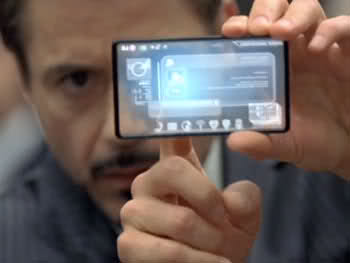Friday Night Fights: Android’s Virtual Buttons Vs. iOS’s Home Button
 Laaaaaaaaaaadies and Gentlemen, welcome to Friday Night Fights, a new series of weekly deathmatches between two no-mercy brawlers who will fight to the death — or at least agree to disagree — about which is better: Apple or Google, iOS or Android?
Laaaaaaaaaaadies and Gentlemen, welcome to Friday Night Fights, a new series of weekly deathmatches between two no-mercy brawlers who will fight to the death — or at least agree to disagree — about which is better: Apple or Google, iOS or Android?
After this week’s topic, someone’s going to be spitting teeth. Our question: Which is better? Android’s three virtual buttons or iOS’s physical home button?
In one corner, we have the 900 pound gorilla, Cult of Mac; in the opposite corner, wearing the green trunks, we have the plucky upstart, Cult of Android!
Place your bets, gentlemen! This is going be a bloody one.
Vincent Messina, Cult of Android
Today we’re going to take a look at the virtual buttons introduced in Android and debate whether or not having software specific on-screen virtual buttons is a better solution to Apple’s single button design.
Most of you are using a device that includes those archetypal hardware or capacitive buttons. You know the ones: home, search, back, menu. Of course as you all know, the order of those buttons also varies manufacturer to manufacturer. The different button locations and lack of manufacturer consistency (along with many other reasons), ultimately led Google to abandoned the static hardware buttons in favor of the new on-screen virtual buttons you find in Honeycomb and Ice Cream Sandwich. In my opinion, this was one of the best decisions by Google, and has taken Android into what I believe will be the future of mobile device design.
While Apple has for years implemented the simple design of a one button function hub (hardware button), I believe having any hardware button(s) to be an unnecessary hindrance to functionality and design aesthetics as we move into a future of larger screens and multimedia content. The advent of the virtual button has created a wealth of newfound functionality, increased flexibility, and an overall better looking phone. Having a hardware button fixed to a particular position of a device limits that designated area space and results in a large bezeled section of unused, wasted space. As we lean more and more towards using our mobile devices for things like gaming and watching movies, this space becomes valuable property that could be put to better use. Take away the iPhone’s hardware button and the bezel that surrounds it and you instantly add an additional inch of screen real estate without changing the size of the phone (now what iPhone user wouldn’t want that?). With that being said, let’s look at some of the advantages of having on-screen virtual buttons.
Gaming
Mobile gaming has advanced tremendously over the years and console quality games on our mobile handsets are now a reality. More people are using their mobile devices as portable hand-held gaming systems, and developers are working towards a multi-platform gaming ecosystem, one where users can take their games anywhere they go. Having more screen on which to enjoy your game and use on screen controls is very important. Gone are the days of cramming virtual D-pads and action buttons into a 3.5″ area. Most importantly, gone are the days of accidentally exiting out of a game due to those annoying capacitive buttons being positioned right where you need to hold your device. I can’t tell you how much my gaming experience has improved since the purchase of my no button Galaxy Nexus. Simply amazing!
Watching Movies
Watching movies and videos has become a visually stunning experience on the larger HD screens, and thanks to the removal of hardware buttons, we can now comfortably hold our devices without worrying about closing out the movie or forcing manufacturers to create larger bulkier phones to compensate for fitting both hardware buttons and a larger screen.
Design
Having universal software specific virtual buttons creates a more consistent and recognizable design across Android and helps with the whole “fragmentation” monkey. Since the virtual buttons can be dimmed or hidden by developers, apps can be made to take advantage of a larger full screen design. Manufacturers can now design slicker, more minimalistic looking devices, void of large ugly bezels and hardware buttons that just look odd when you’re holding your device in multiple orientations.
Mods
With Android and its open environment, the modding possibilities for virtual buttons is endless. With software controlled virtual buttons, mods can be created to provide a wealth of additional information and customizations. Custom text and colors can be added to the virtual buttons, and even entire new buttons can be added or removed to fit a user’s needs. Maybe you prefer only one Applesque button, or perhaps you miss the old 4 button setup, mods can make it possible. You can be completely free of hardware forced design and create your own personal setup thanks to software based virtual buttons.
Overall
In conclusion, having on-screen virtual buttons that change orientation with you, create a more functional and easier experience while freeing users and manufacturers from hardware constraints. They free up unused space and allow for larger screens without the need to increase the overall size of a device. They provide a more optimal gaming experience and help encourage greater multimedia experiences via larger screens. I believe the hardware buttons have outlived their use and will go the way of the dinosaur very soon. There’s simply no need for them when they can be built into the software, and my money is on a buttonless future. As we approach the new age of flexible screens and transparency concepts, the only way we’re going to see Tony Stark’s future phone, is if we get rid of the buttons.
John Brownlee, Cult Of Mac
Apple’s minimalistic philosophy when it comes to physical buttons starts way back in the early 80s, when Steve Jobs took the design of the first mouse from Xerox’s PARC labs and, to make it cheaper, dropped all but one mouse button. It’s an obsession that has continued unabated ever since, most recently culminating (on the mouse front) in the buttonless, multitouch Magic Mouse and Magic Trackpad.
When Apple released the first iPhone, they applied the same concept towards buttons in phones as they had with mice. Instead of having a T9-interface or QWERTY keyboard, the iPhone shipped with just one physical interface button. It was the iconic iOS home button, a small round button slap in the center of the bottom of the device and tattooed with a simple, rounded-edge square. The button only did one thing by itself — brought you to the homescreen — but Apple had seen the truth: once you have a touchscreen, one button is all you need.
It’s a memo Google never got. When Google remade Android in the image of iOS as a touchscreen operating system in late 2007, they decided that every Android phone should ship with four hardware buttons: Search, Home, Back And Menu. Giving credence to Apple’s “one button to rule them all” approach, all of these buttons except home are basically made redundant by a solid software UI.
• Search – It makes sense, of course, that Google of all people wanted to push a dedicated search button on customers, but it’s unnecessary. Most apps don’t actually require search functionality, making a universal hardware button for it pointless, and for the apps that do require search, a software search box does the trick just as well. It’s telling that this was the first hardware interface button many handset makers started leaving off their devices entirely (for example, Samsung).
• Menu – Again, having a dedicated hardware button for menu is something that can be handled just as well by a touchscreen UI. What’s so confusing about Menu on Android is that it’s not consistent: sometimes it will lead to app settings, sometimes to favorites, sometimes to shortcuts, and sometimes not do anything. If a hardware interface button is going to be so inconsistent and superfluous, why have it all?
• Back – Android certainly has its share of ‘Back’ button defenders, but the biggest problem with the Back button, like most of Android’s buttons, is its inconsistency. Using Android’s back button is a mystery: it doesn’t tell you where it’s taking you to, it assumes you, as a user, know exactly where you are and where you have been. Compare this to iOS’s virtual back button, which always tells you where you’re going and never moves you out of an app (that’s what the Home button is for).
Given all the above, I can see why you’d think that Google’s recent decision to give device makers the option of abandoning physical buttons altogether by building virtual buttons into Honeycomb and Ice Cream Sandwich are a move in the right direction. But I don’t. It seems just like typical Android half-assedness: a bizarre attempt to one-up Apple in a buttonless game Cupertino’s not actually trying to play.
Here’s the main question I’d ask: if Android’s interface buttons are superfluous enough to abandon physically, why do you need them to be built into the core OS virtually? In other words, if a device doesn’t really need a Search hardware button, or a Menu hardware button, then why not just allow developers to build on-screen elements for these functions as they see fit? Why have universal software buttons at all? What’s the point?
The point is backwards compatibility, of course. The Android Marketplace is filled with apps that have been — to one extent or another — programmed with those buttons in mind, and ditching them entirely would cause many of these apps to stop working. The virtual buttons, then, are basically a graceless stop-gap: hardcoded Ice Cream Sandwich support for antiquated apps. They’re pointless.
Pointless… and fundamentally broken. Alan Zeino has a great post about this over at his blog, but what it all comes down to is that Google has replaced dumb hardware buttons with equally dumb virtual buttons. Zeino’s summary? “There is no science nor structure to this navigation system at all, and I shudder to think of what a novice… might think of this utter clusterfuck.”
That says it well. Whether you’re using four physical Android buttons or three virtual Android buttons, there’s no universal “science or structure” to trying to navigate Android using its built-in interface buttons. Maybe Vincent’s right and we don’t need hardware buttons at all anymore, but pointing to Android as being proof of that presumed fact is priceless. Android’s having no more luck getting its software buttons right than it did getting its hardware buttons right. Android’s buttons — whether virtual or hard — are a morass of confusing contradictions.
Now compare that to iOS and its home button. Maybe it doesn’t need to be physical, maybe it does, but it works. The home button always goes to the homescreen. Everything else is handled by in-app UI. Serene. Simple. Stress-free. And iconic. Just the way Apple likes it.
Well, readers? You’ve seen us trade blows, but if this fight spills out onto the street about Android vs. iOS, whose back would you take? Let us know in the comments.





